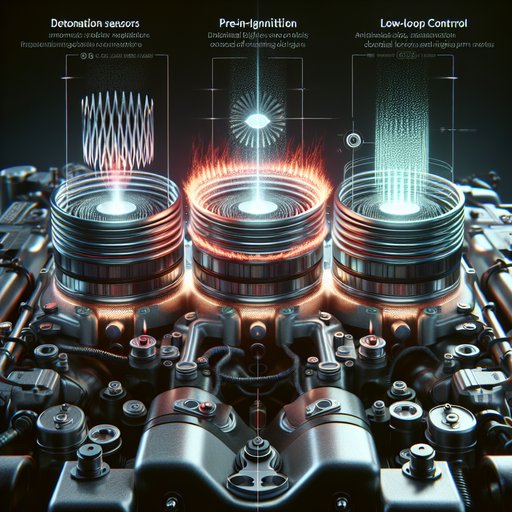
Abnormal combustion in spark-ignition engines appears in three distinct forms: detonation (knock), pre‑ignition, and low‑speed pre‑ignition (LSPI). They differ in when ignition occurs, how pressure rises, and the resulting damage risk. Modern controls—knock sensors, ion‑sensing at the spark plug, and closed‑loop spark/boost—manage each with tailored strategies. Understanding the mechanisms and the sensing windows is critical, because knock is often manageable and even allowed at low levels, while pre‑ignition and LSPI are stochastic and potentially catastrophic, demanding rapid detection and torque reduction rather than the gentle spark trimming used for ordinary knock.
In normal combustion the spark initiates a flame kernel near top dead center (TDC) that propagates across the chamber. Pressure rises smoothly, peaking typically 10–18 crank degrees after TDC; maximum pressure rise rates reside around 5–15 bar/deg CA. Abnormal modes disturb this sequence. Detonation (knock) is end‑gas autoignition that occurs after the spark during the normal burn; pre‑ignition is unintended ignition before the commanded spark; LSPI is a specific, low‑speed/high‑load pre‑ignition phenomenon in turbocharged gasoline direct‑injection (GDI) engines, linked to oil‑fuel droplets and deposits.
Detonation happens when the unburned “end‑gas” reaches autoignition conditions due to high pressure, temperature, and time—driven by compression ratio, charge temperature, boost, residuals, and octane (RON/MON). It occurs close to normal peak pressure and superimposes high‑frequency pressure oscillations (roughly 5–12 kHz in typical 80–95 mm bores). Borderline knock can be tolerated and managed; heavy knock chips ring lands and erodes piston crowns. Pre‑ignition, by contrast, lights the charge well before TDC from hot spots (glowing deposits, overheated plug, exhaust valve edges).
The early burn raises pressure while the piston is still rising, producing extreme peak pressures and pressure‑rise rates that can exceed 20–40 bar/deg CA, far more damaging than ordinary knock. LSPI is a subtype of pre‑ignition most common at 1,000–3,000 rpm, high load, with boosted intake pressures (MAP 1.5–2.5 bar absolute) and slightly rich mixtures (lambda 0.85–0.95) used for component cooling. Evidence points to ignition of localized oil‑fuel droplets from ring‑pack crevices or PCV carryover; calcium‑rich detergent packages in some oils historically increased LSPI frequency. Unlike knock, LSPI is stochastic: a single cycle can see pre‑TDC ignition, producing peak cylinder pressures of 120–200+ bar in engines that normally run 60–90 bar, often fracturing top ring lands.
Raising fuel octane helps knock but is not a reliable LSPI cure; calibration, oil chemistry, and hardware (PCV/oil separation) matter more. Sensing and timing strategy reflect these differences. Piezoelectric knock sensors measure block vibration; the ECU band‑passes the signal around the expected knock frequency and listens in a “knock window” (typically 5–40 deg after spark or near peak pressure). When a knock index exceeds threshold, the ECU retards spark in small steps (about 0.5–1.5 deg) on the affected cylinder, then slowly re‑advances toward MBT (minimum spark for best torque).
Coupled actuators include boost/wastegate, intake valve phasing to increase effective EGR, and mixture enrichment under high load. This closed loop keeps operation at or just shy of the knock limit to maximize efficiency and torque without audible ping. Ion‑sensing uses the spark plug as a probe: a bias voltage applied after the spark measures ion current proportional to in‑cylinder plasma/ions. It can detect knock via high‑frequency content like an accelerometer, but its key advantage is visibility before the knock window—rising ion current before the scheduled spark reveals pre‑ignition.
That enables immediate torque‑cut actions (fuel cut on the cylinder, boost dump, throttle close) within a few cycles, critical for LSPI where spark retard is ineffective because ignition preceded the spark. Some systems combine both sensors; a few applications use in‑cylinder pressure sensors for development or limited series to model heat release and constrain pressure‑rise rate directly. Calibrations manage risk by shaping the boundary conditions: avoiding end‑gas autoignition (detonation) with appropriate octane (typically RON 91–98), charge cooling (intercoolers, 5–20% internal EGR via cam phasing), and mixture control; under heavy load many boosted engines target lambda 0.85–0.90 to reduce exhaust and piston temperatures at the cost of fuel economy and higher CO/HC/PM. For pre‑ignition/LSPI, strategies include limiting boost and spark advance at low rpm, split/late injections to reduce wall wetting, switching to port fuel injection at low‑speed/high‑load in dual‑injector systems, improved PCV/oil separation, and recommending low‑LSPI oils (rebalanced Ca/Mg detergent packages).
Software typically includes per‑cylinder knock adaptives and separate LSPI counters that trigger temporary torque ceilings after an event. Implications: Robust knock control lets engines run closer to MBT, improving part‑load efficiency and transient response; the trade‑off is occasional spark retard and enrichment that raise fuel use and emissions. Ion‑sensing or pressure‑based detection adds cost but reduces catastrophic risk from pre‑ignition/LSPI by enabling faster intervention. LSPI‑oriented oil and PCV hardware improve reliability without fuel penalties, while calibration limits at low speed can slightly soften peak torque.
In well‑tuned systems, audible knock is rare, LSPI events are extremely infrequent, and real‑world drivability remains smooth with strong low‑end torque, meeting durability and emissions targets under regulations such as current light‑duty standards.












